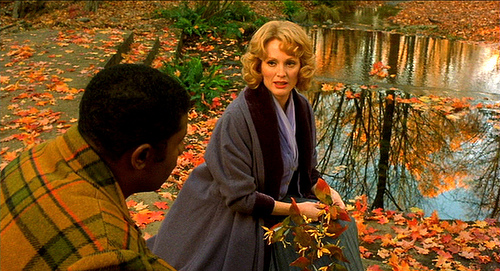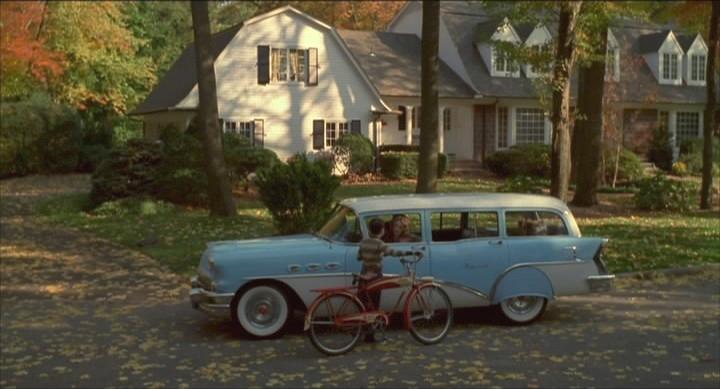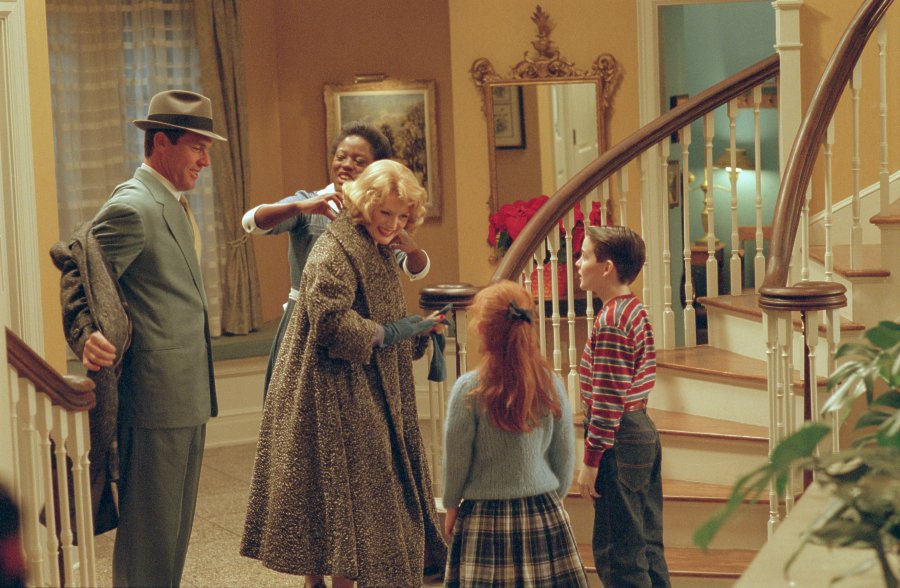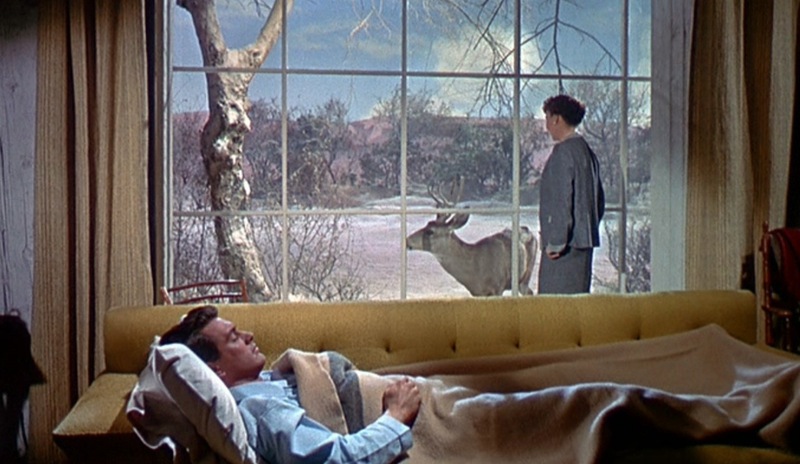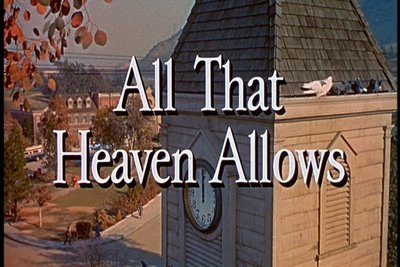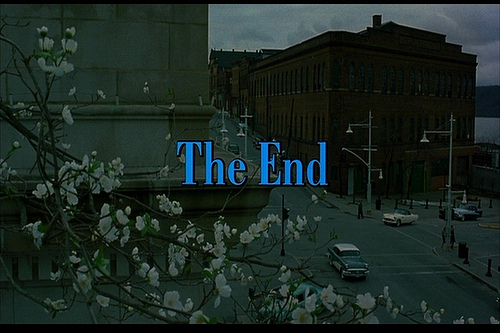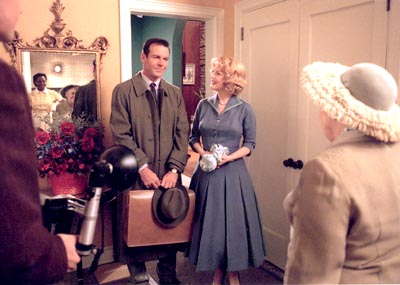From the November 22, 2002 Chicago Reader. — J.R.
Far From Heaven
**** (Masterpiece)
Directed and written by Todd Haynes
With Julianne Moore, Dennis Quaid, Dennis Haysbert, Patricia Clarkson, Viola Davis, and James Rebhorn.
It becomes apparent that in this context, for practical purposes, “Sirk” does not denote a mood or a philosophy or a set of plot elements, but rather a repertoire of technical decisions. With that lexicon of effects, new sentences can be written. — Geoffrey O’Brien, writing on Far From Heaven in the November issue of Artforum
Todd Haynes’s Far From Heaven — a revisionist pastiche of the Technicolor melodramas Douglas Sirk made for Universal Pictures in the 1950s — was easily, and in some ways deservedly, the most popular movie among critics at the Toronto film festival in September. Though less obviously a tour de force than many flashier recent art films, such as Alexander Sokurov’s one-take feature Russian Ark, it’s no less impressive as a technical achievement.
Despite the Toronto buzz, Far From Heaven may not become a hit, even in art theaters (though I’ve heard it had a strong opening week at the Landmark). Having twice discussed it with audiences (as part of Talk Cinema screenings at Northbrook and Pipers Alley), I’ve seen how it can divide viewers. Its partisans tend to be much more passionate than its detractors. Some of the partisans are young, but many of the divisions are generational. The more receptive viewers tend to be old enough to remember the late 50s and to have seen Sirk films such as All That Heaven Allows and Written on the Wind (to list the two now available on DVD, both in splendid Criterion editions). If we had an enlightened film culture that extended beyond outlets such as Tower Records and Virgin Megastore to multiplexes such as Landmark’s Century Centre (which are, after all, fed by the same conglomerates), we’d have a rerelease of All That Heaven Allows to accompany Far From Heaven — not only because Haynes’s movie is an imaginative rethinking and recasting of Sirk’s, but because the two films inform each other in numerous ways (luckily the Music Box will be showing All That Heaven Allows in weekend matinees next month). Sirk’s film is about an upscale suburban widow (Jane Wyman) successfully bucking her two kids’ and her community’s disapproval of her romance with her gardener (Rock Hudson), a much younger man; Far From Heaven is about a suburban woman, married to a closeted gay executive and with two kids, who fails to buck her community’s disapproval of her potential romance with her black gardener.
Significantly, Haynes, who was born in 1961, is splitting with some members of his generation by treating his Sirkian material with sincerity and respect rather than ridicule or cynicism. When he shows the gardener (Dennis Haysbert) suggesting to the heroine at an art gallery that perhaps abstract art is continuing from where religious art left off, we aren’t invited to scoff or snort — as we might be when the widow in All That Heaven Allows is told by the enlightened country folk that her gardener hasn’t read Thoreau’s Walden but “just lives it.” Haynes invites us to share and appreciate the insight. And though his gardener seems almost as much of a paragon and relaxed overachiever as Sidney Poitier’s doctor in Guess Who’s Coming to Dinner (1967), this gallery sequence registers as simple and truthful — light-years beyond Oscar-bound self-righteousness and star turns.
It’s a nervy, moving achievement, though I have to admit that Haynes’s piety entails a certain postmodernist sleight of hand. That’s because only part of what he’s being sincere about deserves to be called social history; the rest is an alluring brand of Hollywood artifice. More precisely, Haynes is deadly accurate about many of the social prisons of American life in the 50s, but less precise when it comes to details. Insofar as he uses Sirk’s opulent productions as an index for that period — and many viewers believe they’re a basically reliable indication of how people lived and acted then, even though they scant racism and homophobia — he’s bound to be off as a historian.
Sirk’s color-coordinated dresses and living rooms, spacious front lawns and gardens, and exquisitely theatrical interior and exterior lighting schemes are so remarkable, and so impressively duplicated in this movie, that it’s easy for us to lose sight of the fact that real people never lived in them, only movie stars. (That Haynes used New Jersey exteriors to get some of the same results Sirk did in a studio is an important part of his technical achievement.) And some of the character traits found in this world are so singular that the references to Sirk may at times overwhelm their impact as social observation. A neurotic character going ballistic when he can’t summon up an erection inevitably becomes a gloss on Robert Stack’s impotent millionaire in Written on the Wind; a beneficent-looking shrink in a bow tie and vest recalls a key spiritual guru in Magnificent Obsession, the 1954 movie that launched Sirk’s color-weepie cycle. I’d argue that the only part of Sirk’s visual style Haynes doesn’t nail are the lush lap dissolves, the overlapping transitions between scenes that are experienced like warm baths; Haynes’s camera movements accompanying the dissolves are less coordinated than Sirk’s.
Of course you can learn a lot about people in any class, country, and period by studying their most overblown fantasies, and the images of upscale suburbia in 50s America — imagined and developed by Sirk and painstakingly reproduced by Haynes — are certainly ripe for unpacking. Haynes is especially good at capturing the implication behind every glossy magazine illustration ideal that we’re all being watched by someone or something — a key tool for oppression during the complacent Eisenhower years. One reason Sirk may have started and ended many of his pictures with God’s-eye views of buildings and foliage was to establish a feeling of hushed religious awe that could imply paranoia. The pointedly titled Far From Heaven properly, if paradoxically, begins in the autumnal treetops — as close to heaven as the movie cares to go — before craning down to Hartford, Connecticut, and environs in the mid-50s, and inevitably concludes 107 minutes later with a crane moving upward toward the first spring blossoms.
The kitschy sense of beauty and reverence that comes from these high camera angles also announces that the necessity of being seen — and, more important, surveyed — is an essential part of this apparent state of grace. That your appearance and behavior are read by your neighbors as if they were details on a map makes visible transgressions the only truly risky ones. There are two main transgressions in Far From Heaven. First is the interracial romance and the possibility of sex — which is introduced when suburban housewife and mother Cathy Whitaker (Julianne Moore) becomes friendly with Raymond Deagan, her “Negro” gardener. Second is the homosexual sex and romance (the chronological order pointedly reversed), which Cathy’s husband, Frank (Dennis Quaid), struggles to hide or avoid during a series of furtive encounters. That he ultimately can conceal his forbidden desires without having to overcome them, while Cathy is forced to do the opposite — display her forbidden desires and then be unable to satisfy them — is one of this movie’s principal subtexts concerning what it meant to be alive and middle-class during the 50s.
It’s worth lingering a little over some of the details that are less persuasive in Haynes’s analysis. Frank’s absence and indifference as a father, evident every time we see him with his son or daughter, is less a clearly defined character trait than a failure of imagination. The same goes for Haynes’s failure to imagine what Frank’s postmarital life might consist of. (Cathy’s postmarital life is easy to imagine, and her sternness with the kids about proper attire and behavior is at least appropriate given the period, but in most other respects Haynes seems no less reluctant to evaluate her as a parent.) A similar failure informs most of the details about the kids, who are used mainly as props or vehicles for plot points.
The black bar and nightclub operating in the sticks with plenty of clients and a dance band in the middle of the afternoon is simply ridiculous, though part of this conceit could have been borrowed from The Bridges of Madison County. (Haynes is more convincing when he shows us a gay bar in downtown Hartford and when he takes the politically incorrect step of showing us a grotesquely affected gay dandy at the art gallery.) Trivial but worth noting are the somewhat unlikely pairs of double features playing at the movie house where Frank searches for furtive sex, which are clearly targeted at different audiences: The Three Faces of Eve with Miracle in the Rain and Hilda Crane with The Bold and the Brave.
Part of the problem with updating Sirk to make room for homophobia and a more comprehensive view of racial intolerance is that it idealizes the social impact of the original Sirk movies when they came out. Admittedly, Haynes is far from alone in this misperception. Since the 70s an entire academic industry — bolstered by the stylistic emulations of Sirk by Rainer Werner Fassbinder (whose beautifully suggestive essay on Sirk is available on the DVD of All That Heaven Allows) — has been built around that idealization, and Haynes undoubtedly imbibed this kind of wishful thinking, along with Roland Barthes’ Mythologies, as a graduate student in Brown University’s semiotics department.
I saw Imitation of Life, Sirk’s last feature, when it came out in 1959 in an all-white theater in northwestern Alabama, surrounded by matrons sobbing over the death of the film’s conservative Aunt Jemima figure. I find it hard to believe that Sirk was slyly subverting racial stereotypes, because no one at the time seemed even remotely aware of the alleged subterfuge. Sirk’s film came out four years after the Montgomery bus boycott and two after troops were sent into Little Rock — which makes it even harder to understand why academics ignored or deemed less progressive John Stahl’s 1934 version of the same story (also titled Imitation of Life), in which the Aunt Jemima figure was the heroine’s business partner and not simply her maid. (Arguably, the more incidental handling of a black maid in Max Ophuls’s 1949 The Reckless Moment — another acknowledged Haynes source — also had a more progressive edge.)
I won’t deny that Sirk was exploring certain contradictions, but I would argue that that’s what most melodramas do — it’s part of their stock-in-trade. So repackaging the bitterness of the onetime leftist Sirk decades later is ultimately a way to flatter rather than challenge the perceptions of a post-60s audience. And despite its unfashionable sincerity and thoughtfulness, Haynes’s update of Sirk runs a comparable risk: it’s always easier to be withering about the past than the present.
Haynes’s previous feature with Julianne Moore, the underrated Safe (1995), is anything but flattering to that same audience. It’s a fascinating companion piece to Far From Heaven, using the same talented actress to explore suburban alienation in comparably gargantuan consumerist surroundings, this time contemporary southern California, through an affliction diagnosed but never quite confirmed as environmental illness. The film confounds us by setting up mysteries it refuses to resolve, forcing us to identify with the helpless drift of a less admirable and less sympathetic housewife than Cathy Whitaker.
Doubts about the relationship between artifice and truth have followed me through multiple viewings of Far From Heaven, yet each time I’ve seen it I’ve found it more moving, not less. I’ve come to realize that my suspicions about Haynes’s ambiguous relation to the period may have as much to do with my own confusion about this material as with his. I’m prepared to believe that his relationship to the material has at least as much emotional and political authenticity as Sirk’s ever did. And I’m touched not so much by the unlikely proximity of kitsch and truth — a combo that’s equally confounding in Leo McCarey’s An Affair to Remember (1957), in the camera placements, the performances of Cary Grant and Deborah Kerr, and the insufferable clichés about artists in garrets juxtaposed with a profound religious sincerity — as by the truth that’s found within the kitsch, at the end of a long train of thought and emotion that began with falsity.
Much of this truth grows directly out of the nuances of Moore’s performance. She manages to capture the distress and anguish of a woman trapped in conventions but with barely a clue about how she got there and none about how to escape, yet she presents this dilemma without ever stooping to belittle the character. Maybe this is because Hollywood conventions and social conventions are two sides of the same coin — traps for the audience no less than the characters — and because our own naive entrapment in movie conventions has so much in common with Cathy’s experience of her social prison.
Geoffrey O’Brien writes astutely in Artforum about this kind of connection in relation to Quaid’s character (sidestepping Sirk by referring to another Universal picture made the same year as Written on the Wind): “The husband’s sexual crisis is handled with an aura of hysteria and pseudoscience appropriate to the period — his anguish and shame call to mind Grant Williams in The Incredible Shrinking Man (1957) angrily rejecting his wife when she attempts to comfort him for his mysterious loss of masculine pride.”
I might add that Frank’s angry rejection of his wife, after emerging from his first session with the benign shrink, includes an explosive line that I can’t conceive of anyone uttering in a 50s Hollywood movie: “Look, I just want to get the whole fucking thing over with!” Such breaches in the conventions that Haynes, his characters, and the audience are studiously following may allow us to find the truths behind as well as beyond the clichés. And so the collision of two exhausted movie clichés, a phony 50s acting style and a standard and utterly banal expression from over a decade later, produces a truth that we can all believe in — much as multiplying two negatives yields a positive.

